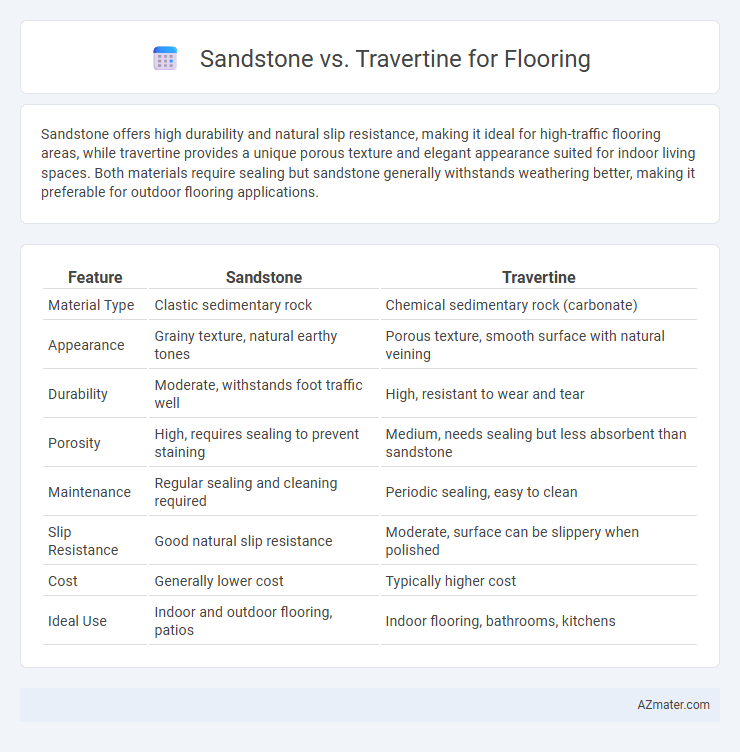Sandstone offers high durability and natural slip resistance, making it ideal for high-traffic flooring areas, while travertine provides a unique porous texture and elegant appearance suited for indoor living spaces. Both materials require sealing but sandstone generally withstands weathering better, making it preferable for outdoor flooring applications.
Table of Comparison
| Feature | Sandstone | Travertine |
|---|---|---|
| Material Type | Clastic sedimentary rock | Chemical sedimentary rock (carbonate) |
| Appearance | Grainy texture, natural earthy tones | Porous texture, smooth surface with natural veining |
| Durability | Moderate, withstands foot traffic well | High, resistant to wear and tear |
| Porosity | High, requires sealing to prevent staining | Medium, needs sealing but less absorbent than sandstone |
| Maintenance | Regular sealing and cleaning required | Periodic sealing, easy to clean |
| Slip Resistance | Good natural slip resistance | Moderate, surface can be slippery when polished |
| Cost | Generally lower cost | Typically higher cost |
| Ideal Use | Indoor and outdoor flooring, patios | Indoor flooring, bathrooms, kitchens |
Introduction to Sandstone and Travertine Flooring
Sandstone flooring offers natural durability and a unique, grainy texture formed from compacted sand particles, providing a warm, earthy aesthetic ideal for both indoor and outdoor spaces. Travertine flooring is composed of calcium carbonate, featuring a distinctive porous surface with natural pits and veining that enhance its elegant, timeless appeal often used in luxury homes and commercial properties. Both materials are sedimentary stones known for their longevity and versatility, but sandstone tends to be more slip-resistant while travertine excels in providing a polished, refined finish.
Key Differences Between Sandstone and Travertine
Sandstone flooring features a coarse-grained texture and earthy tones, offering durability and slip resistance ideal for high-traffic areas. Travertine, characterized by its porous surface and smooth finish with natural pits, presents elegant variation in cream, beige, and rust colors, commonly filled and polished for indoor flooring. Sandstone is generally more affordable and weather-resistant, while travertine provides a classic, luxurious appearance but requires regular sealing to maintain its longevity.
Appearance and Aesthetic Appeal
Sandstone flooring offers a warm, natural look with unique grain patterns and earthy tones that enhance rustic and traditional interiors. Travertine features a smoother surface with distinctive pitted holes and veins, delivering a sophisticated and elegant appearance ideal for classic and Mediterranean styles. Both stones provide durable options, but travertine's polished finish creates a more refined aesthetic compared to the matte, textured appeal of sandstone.
Durability and Longevity Comparison
Sandstone flooring offers moderate durability with a hardness rating between 6 and 7 on the Mohs scale, making it suitable for low to medium traffic areas but prone to scratching and erosion over time. Travertine, rated around 6 to 6.5 on the Mohs scale, provides higher density and resistance to wear, enhancing its longevity in high-traffic zones when properly sealed. Both natural stones require periodic maintenance, but travertine's compact structure and superior durability typically result in a longer lifespan compared to sandstone floors.
Maintenance and Cleaning Requirements
Sandstone flooring requires regular sealing to prevent moisture absorption and staining, with gentle cleaning using pH-neutral cleaners to avoid surface damage. Travertine demands frequent sealing due to its porous nature and is best cleaned with mild detergents and soft cloths to maintain its polished finish. Both materials benefit from prompt spill cleanup and avoidance of acidic or abrasive cleaners to preserve their durability and appearance.
Slip Resistance and Safety Features
Sandstone flooring offers excellent slip resistance due to its naturally rough texture, making it a safer choice for areas prone to moisture. Travertine, while aesthetically appealing with its smooth, porous surface, often requires sealing to enhance slip resistance and prevent surface wear. Both materials provide durable options, but sandstone typically ensures better safety features in slippery environments without extensive maintenance.
Cost Comparison: Sandstone vs Travertine
Sandstone flooring typically costs between $5 to $15 per square foot, making it a more budget-friendly option compared to travertine, which ranges from $7 to $30 per square foot. Installation expenses for sandstone are generally lower due to its softer texture, while travertine requires more specialized labor, increasing overall costs. Maintenance and durability factors may affect long-term expenses, with travertine often demanding higher upkeep than sandstone.
Environmental Impact and Sustainability
Sandstone and travertine flooring differ significantly in environmental impact and sustainability, with sandstone being a more eco-friendly option due to its abundant natural availability and minimal processing requirements. Travertine, while aesthetically appealing, involves intensive quarrying and chemical treatments that increase its carbon footprint and environmental degradation. Choosing sandstone supports sustainable building practices by reducing energy consumption and preserving natural habitats compared to the higher resource demands associated with travertine extraction and refinement.
Best Applications and Use Cases
Sandstone flooring excels in outdoor applications such as patios, walkways, and pool surrounds due to its durability and slip-resistant texture. Travertine is best suited for indoor flooring in areas like kitchens, bathrooms, and living rooms because of its elegant appearance and ability to handle moisture effectively. Both stones offer distinct aesthetic and functional benefits, making sandstone ideal for rugged, high-traffic environments and travertine perfect for sophisticated, moisture-prone interiors.
Final Verdict: Which Flooring is Right for You?
Sandstone offers a warm, earthy aesthetic with excellent durability and slip resistance, making it ideal for outdoor areas or high-traffic spaces. Travertine provides a luxurious, polished appearance with softer tones and a naturally porous texture that requires regular sealing to maintain its beauty indoors. Choosing between sandstone and travertine depends on your design preference, maintenance willingness, and specific flooring needs, with sandstone favored for rugged durability and travertine preferred for elegant interiors.

Infographic: Sandstone vs Travertine for Flooring
 azmater.com
azmater.com